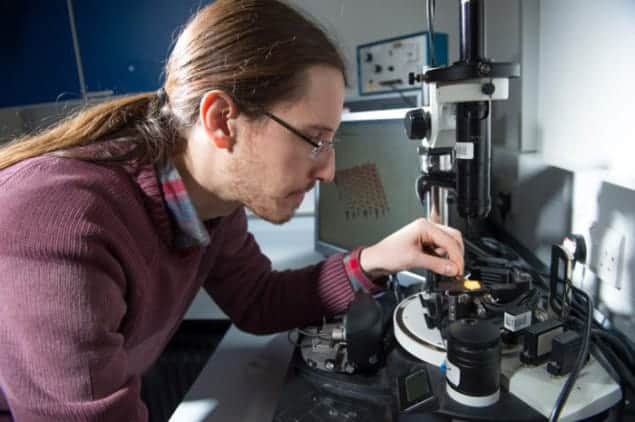
A new physical mechanism that causes particles of different sizes to separate as paint dries has been identified by physicists in the UK and France. Based on computer simulations and experiments, the research suggests that smaller particles join forces to push larger particles in one direction, resulting in stratified layers of dried material. The work upends conventional wisdom about how paint dries and could lead to the development of new techniques for making layered materials.
When a thin liquid film containing paint or other tiny particles dries on a surface, two competing effects drive their motion. One is random Brownian motion, which is an equilibrium-seeking process that tends to distribute the particles evenly throughout the film. The other is evaporation, which tends to drive the system away from equilibrium and can lead to the self-organization of large-scale structures. Tiny particles in a disc of spilled coffee, for example, move towards the edge during evaporation to create a familiar “coffee ring”.
In mixtures with particles of two different sizes, the smaller particles have faster Brownian motion than the larger particles, and so should redistribute themselves away from the evaporating surface of the mixture more quickly than the larger particles. Larger particles should therefore build up on the air side of an evaporating film, with smaller particles on the other side.
Upside down
Now, Andrea Fortini, Ignacio Martín-Fabiani and colleagues at the University of Surrey and the University of Claude Bernard Lyon have found that the opposite is true in the mixtures they have studied. Smaller particles, they found, congregate near the air surface, not on the other side.
The researchers discovered this surprising effect by first doing computer simulations of a number of different mixtures containing large and small spherical particles with different relative sizes. They also simulated mixtures with different relative abundances of large and small particles.
They found that the larger particles move away from the air interface for mixtures in which the ratio of the particle diameters ranged from 2:1 to 14:1. However, for separation to occur there had to be at least 200 times more small particles than large particles in the mixture. These theoretical predictions were backed up by atomic force microscopy experiments using acrylic paints that contain particles with diameters of 55 nm and 385 nm, which have a ratio of 7:1.
Inward force
The team has come up with an explanation for the surprising effect that is based on an analysis of the forces on individual particles. As liquid evaporates, the density of particles near that surface increases, creating an inward force as the particles try to move away from the surface. By considering how the particles push against each other, the researchers worked out that the inward velocity of a particle is proportional to the square of its diameter. For the paint, large particles should therefore move 49 times faster than the small particles – something that was observed experimentally.
Understanding this effect, Fortini says, could lead to a range of useful materials. “This type of ‘self-layering’ in a coating could be very useful,” he says. “In a sunscreen, most of the sunlight-blocking particles could be designed to push their way to the top, leaving particles that can adhere to the skin near the bottom of the coating.” Other possible applications include creating layered films for electronics, ink printing and, of course, better paint.
The research is described in Physical Review Letters.



